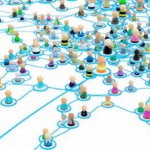My first job back in the early 90’s was as a systems analyst. I was really excited about automating boring bits of peoples’ tasks so that they could get creative by accessing the extra brainpower of a computer in some wonderful human-computer collaboration.
Inspired by Doug Lenat’s AM (Automated Mathematician), where the computer was discovering mathematical proofs, I wanted to find a way to create some sort of integrated system with the computer discovering things and the human adding information to represent their feel for a given situation.
Of course, in the Accounts Department where I was ‘helping’ accountants, the reality was very different. Computers weren’t the powerful, easy to use machines they are today. So, by introducing technology to various user groups, I was actually telling people to do their jobs differently. I wasn’t making the world a better place, I was hampering everyone with computers. And elsewhere in the company I worked, computers were replacing people altogether. No wonder, computers were not popular. How times have changed.
For me, human-computer interaction was and still remains Gestaltian: The whole is greater than the sum of the parts, by this I mean, that the collaboration of a human and a computer should be more than a human typing numbers into a computer and then waiting for the solution.
When I looked up Gestalt Theory, I learnt that Kurt Koffka’s original phrase was The whole is other than the sum of the parts, which works just as well. And did, when I was captivated by AI research, in particular constraint theory.
I loved the idea that if you had a space of solutions, you could explore it computationally by changing variables which represented specific design objectives such as the limit of the cost of the project, and then create other and varying solutions.
But, how often do we need something other and varying? The majority of users I have worked with love their jobs and have specific end goals for which they use computers.
When I was working alongside engineers my job was to interpret the massive data sets generated by fibre optic sensors on the bridges they monitored. I created GUIs which employed the terminology and symbolic language engineers are trained to use. The GUIs sat onto top of well-known models to interpret data. And to reflect this specific nature of engineer-computer interaction, I actually called it a sub-set of human-computer interaction. The engineers were doing something newish – monitoring bridges- but they were using the way they were trained because of the laws and health and safety when looking after the infrastructure society depends upon.
The engineers would only use something they could trust.
And that got me thinking about the whole creativity computational collaboration. Do we really need super extra powerful computers to have a creative collaboration? Or do we just need something trustworthy?
When I began this blog post – a long time ago – I had a first sentence which said: How to improve the intellectual effectiveness of the individual human being.
Now, I can barely remember what I was going to say. But googling the phrase produces millions of articles and Doug Engelbart, who was a pioneer in computing. He invented the mouse and was very much into harnessing computational power to help humans and augment their capacities. This side steps the issue of trust, because ultimately the augmented human would decide whether the collaboration of computer and human produced the right solution. And humans normally trust themselves.
Steve Mann has been augmenting his capacity for over 20 years with wearables which overlay his world view with lots of information taken from the Internet. Stelarc augmented his reality by having an ear surgically attached to his arm so that he could hear random people’s conversations again via the Internet.
Their solutions don’t involve vast computational power and they are not really solving anything. They are looking differently at augmenting humans. But both use two things:
- Connectivity
- Other people
And this is what social media does, but in a quick and easy way. Via social media, it is so easy to access a) random conversation like Sterlac, or b) information about a new town you are in like Steve Mann.
But it is not just information we want, which was what clever computers and AI realised. We want intelligence and the expertise of someone else, who is constantly updating and refreshing their world view.
Social media gives us that in a way a clever computer cannot – yet!.
This morning alone, I tapped into three experts to help me do yoga, meditate and feel more at peace:
- I took a yin yoga class led by Travis Elliot.
- I listened to a free lecture in the Hay House World Summit Series by davidji about destressifying yourself with a 16-seconds meditation practice
- And, I did Lesson 4 of 6 on Iyanla Vanzant’s Forgiveness course. (I paid for that one but it is well worth the money.)
Those experiences augmented and enriched my life and left me more peaceful and happy. I could not have done without the help of those experts or social media unless I took time off and went off to find these experts.
So, it seems that social media is one amazing way of augmenting humans. And when I think of me back in the accounts department evangelising about how computers could transform our lives, I had no idea how right I was, just not at all in the way I imagined.
We live in amazing times.







9 comments